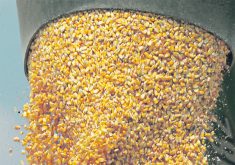Confidence is oozing back into the once-moribund canola oil industry.
The recovery might allow all, from farmer to crusher to retailer, to profit simultaneously.
“The whole complex seems to be lifting,” said Robert Broeska, executive director of the Canadian Oilseed Processors Association.
“There’s already strong demand for food use, and now there’s fuel as well.”
For years, the industry has lurched along, yanked by surges of supply and demand. At times the supply chain is yanked by crop shortfalls, so farmers make money while crushers stumble.
Read Also

Chinese, Indian tariffs take toll on pea prices
The disruption of pea exports from Canada’s largest customers will likely result in slow pea exports for the remainder of the crop year.
At other times, like today, crushers race forward while farmers regret being dragged down by last summer’s heavy crop.
But analysts believe the mushrooming biodiesel industry will lead to long-term bigger, consistent demand, and variety development will lead to more stable supply, so it should be possible for the whole industry to be generally profitable.
Fortunately for farmers, the worldwide surge in demand for vegetable oils is likely to come before improvements in crop science increase the average supply of canola.
That’s not bad for the overall canola industry either, said Canola Council of Canada president Barb Isman, because it won’t thrive unless farmers are making money.
“It does depend on the availability of production, and availability of production depends on returns for farmers,” said Isman.
Within a few years, North American biodiesel production should consume more than two million tonnes per year of Canadian canola, and about one million tonnes will be crushed on this side of the Atlantic for the European market.
That will create more intense demand for canola, which should give farmers better prices and cut out low-value export markets.
“Some of the marginal seed export markets might be out,” said Isman.
But the well-paying traditional buyers of canola will still be able to get supply.
“Even if you had Canadian biodiesel, EU and American (biodiesel), you still wouldn’t short the food market,” said Isman.
New varieties with drought and other stress tolerances will lower the risk of crop failure and lead to bigger crops.
The pod shatter problem is also being minimized. Brassica juncea varieties are expanding canola’s reach into the hotter, drier portions of the Prairies and U.S. great plains farm belt.
“Over time, we think there are enough agronomic prospects that you can serve everybody.”
But the boom now is in demand, not production, and it’s unlike any experienced before.
“In the food business (growth tends to be) incremental. You grow two to three percent on average, but if you do really, really well, you grow five to six percent,” said Isman. “Well, we’re talking potentially about an increase in the demand for vegetable oils over the next three years of 50 percent.”















